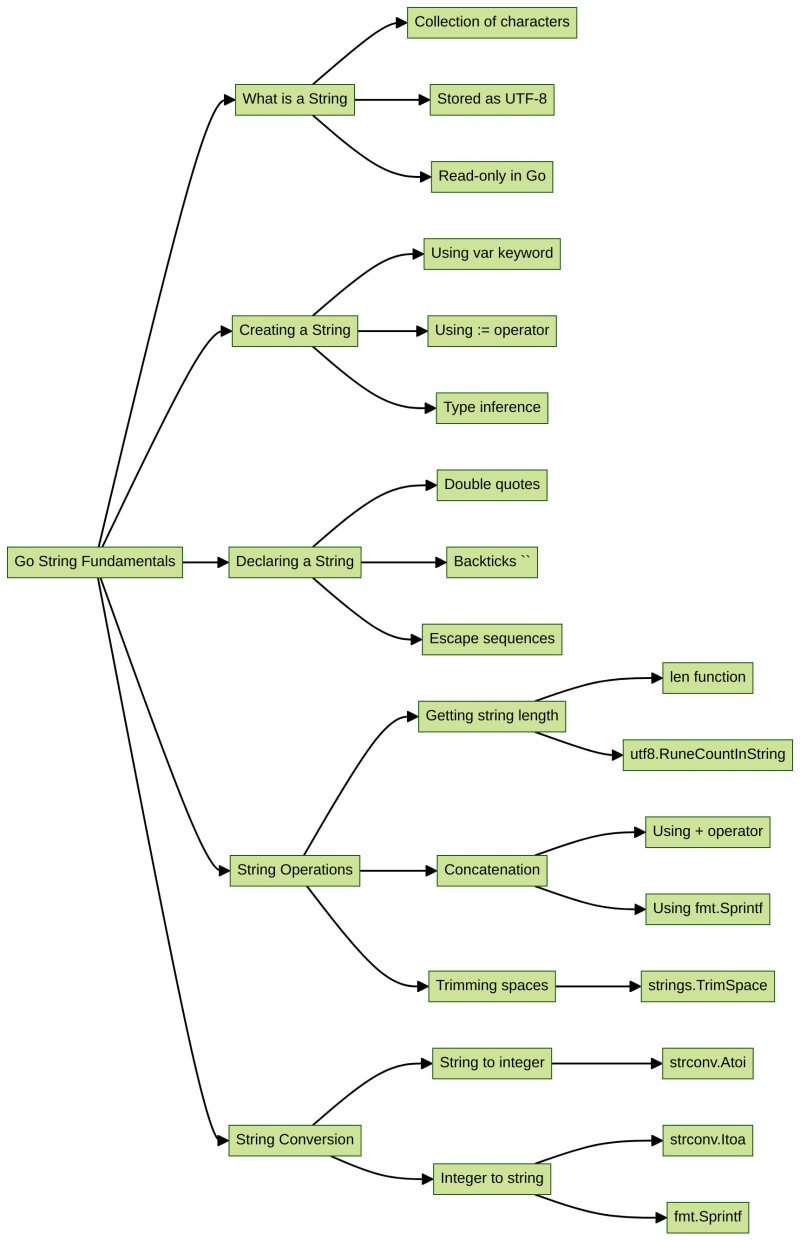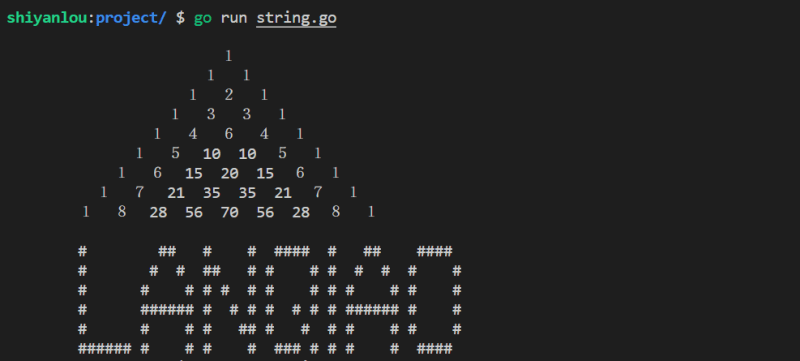프로그래밍으로 이동 | 문자열 기초 | 문자 인코딩
소개

이전 강의에서 우리는 Go의 문자가 UTF-8을 사용하여 인코딩되고 바이트 또는 룬 유형으로 저장된다는 것을 배웠습니다. 이제 문자 집합인 문자열에 대해 이야기해 보겠습니다. 함께 배워볼까요
지식 포인트:
- 문자열이란 무엇입니까
- 문자열 만들기
- 문자열 선언
- 일반적인 문자열 함수
문자열이란 무엇입니까?
Go에서 배운 첫 번째 프로그램에서는 hello, world라는 문자열을 인쇄했습니다.
문자열은 Go의 기본 데이터 유형으로 문자열 리터럴이라고도 합니다. 이는 문자의 집합으로 이해될 수 있으며 지속적인 메모리 블록을 차지합니다. 이 메모리 블록은 문자, 텍스트, 이모티콘 등 모든 유형의 데이터를 저장할 수 있습니다.
그러나 다른 언어와 달리 Go의 문자열은 읽기 전용이므로 수정할 수 없습니다.
문자열 만들기
문자열은 여러 가지 방법으로 선언할 수 있습니다. 첫 번째 방법을 살펴보겠습니다. string.go라는 새 파일을 만듭니다:
다음 코드를 작성하세요:
위 코드는 var 키워드와 := 연산자를 사용하여 문자열을 생성하는 방법을 보여줍니다. var로 변수 생성 시 값을 할당하면 변수 b 생성과 같이 타입 선언을 생략할 수 있습니다.
예상 출력은 다음과 같습니다.
문자열 선언
대부분의 경우 문자열을 선언할 때 큰따옴표 ""를 사용합니다. 큰따옴표의 장점은 이스케이프 시퀀스로 사용할 수 있다는 것입니다. 예를 들어, 아래 프로그램에서는 n 이스케이프 시퀀스를 사용하여 새 줄을 만듭니다.
예상 출력은 다음과 같습니다.
다음은 몇 가지 일반적인 이스케이프 시퀀스입니다.
| 기호 | 설명 |
|---|---|
| n | 새로운 라인 |
| r | 운송 반납 |
| t | 탭 |
| b | 백스페이스 |
| \ | 백슬래시 |
| ' | 작은따옴표 |
| " | 큰따옴표 |
If you want to preserve the original format of the text or need to use multiple lines, you can use backticks to represent them:
package main
import "fmt"
func main() {
// Output Pascal's Triangle
yangHuiTriangle := `
1
1 1
1 2 1
1 3 3 1
1 4 6 4 1
1 5 10 10 5 1
1 6 15 20 15 6 1
1 7 21 35 35 21 7 1
1 8 28 56 70 56 28 8 1`
fmt.Println(yangHuiTriangle)
// Output the ASCII art of "labex"
ascii := `
# ## # # ### # ## ####
# # # ## # # # # # # # #
# # # # # # # # # # # # #
# ##### # # # # # # # ##### # #
# # # # ## # # # # # # #
##### # # # # ## # # # # ### `
fmt.Println(ascii)
}
After running the program, you will see the following output:

Backticks are commonly used in prompts, HTML templates, and other cases where you need to preserve the original format of the output.
Getting the Length of a String
In the previous lesson, we learned that English characters and general punctuation marks occupy one byte, while Chinese characters occupy three to four bytes.
Therefore, in Go, we can use the len() function to get the byte length of a string. If there are no characters that occupy multiple bytes, the len() function can be used to approximately measure the length of the string.
If a string contains characters that occupy multiple bytes, you can use the utf8.RuneCountInString function to get the actual number of characters in the string.
Let's see an example. Write the following code to the string.go file:
package main
import (
"fmt"
"unicode/utf8"
)
func main() {
// Declare two empty strings using var and :=
var a string
b := ""
c := "labex"
// Output byte length
fmt.Printf("The value of a is %s, the byte length of a is: %d\n", a, len(a))
fmt.Printf("The value of b is %s, the byte length of b is: %d\n", b, len(b))
fmt.Printf("The value of c is %s, the byte length of c is: %d\n", c, len(c))
// Output string length
fmt.Printf("The length of d is: %d\n", utf8.RuneCountInString(d))
}
The expected output is as follows:
The value of a is , the byte length of a is: 0 The value of b is , the byte length of b is: 0 The value of c is labex, the byte length of c is: 5 The length of d is: 9
In the program, we first declared two empty strings and the string labex. You can see that their byte lengths and actual lengths are the same.
Converting Strings and Integers
We can use functions from the strconv package to convert between strings and integers:
package main
import (
"fmt"
"strconv"
)
func main() {
// Declare a string a and an integer b
a, b := "233", 223
// Use Atoi to convert an integer to a string
c, _ := strconv.Atoi(a)
// Use Sprintf and Itoa functions respectively
// to convert a string to an integer
d1 := fmt.Sprintf("%d", b)
d2 := strconv.Itoa(b)
fmt.Printf("The type of a: %T\n", a) // string
fmt.Printf("The type of b: %T\n", b) // int
fmt.Printf("The type of c: %T\n", c) // int
fmt.Printf("The type of d1: %T\n", d1) // string
fmt.Printf("The type of d2: %T\n", d2) // string
}
The expected output is as follows:
The type of a: string The type of b: int The type of c: int The type of d1: string The type of d2: string
In the program, we use the Sprintf() function from the fmt package, which has the following format:
func Sprintf(format string, a ...interface{}) string
format is a string with escape sequences, a is a constant or variable that provides values for the escape sequences, and ... means that there can be multiple variables of the same type as a. The string after the function represents that Sprintf returns a string. Here's an example of using this function:
a = Sprintf("%d+%d=%d", 1, 2, 3)
fmt.Println(a) // 1+2=3
In this code snippet, the format is passed with three integer variables 1, 2, and 3. The %d integer escape character in format is replaced by the integer values, and the Sprintf function returns the result after replacement, 1+2=3.
Also, note that when using strconv.Atoi() to convert an integer to a string, the function returns two values, the converted integer val and the error code err. Because in Go, if you declare a variable, you must use it, we can use an underscore _ to comment out the err variable.
When strconv.Atoi() converts correctly, err returns nil. When an error occurs during conversion, err returns the error message, and the value of val will be 0. You can change the value of string a and replace the underscore with a normal variable to try it yourself.
Concatenating Strings
The simplest way to concatenate two or more strings is to use the + symbol. We can also use the fmt.Sprintf() function to concatenate strings. Let's take a look at an example:
package main
import (
"fmt"
)
func main() {
a, b := "lan", "qiao"
// Concatenate using the simplest method, +
c1 := a + b
// Concatenate using the Sprintf function
c2 := fmt.Sprintf("%s%s", a, b)
fmt.Println(a, b, c1, c2) // lan qiao labex labex
}
The expected output is as follows:
lan qiao labex labex
In the program, we also used the Sprintf() function from the fmt package to concatenate strings and print the results.
Removing Leading and Trailing Spaces from a String
We can use the strings.TrimSpace function to remove leading and trailing spaces from a string. The function takes a string as input and returns the string with leading and trailing spaces removed. The format is as follows:
func TrimSpace(s string) string
Here is an example:
package main
import (
"fmt"
"strings"
)
func main() {
a := " \t \n labex \n \t hangzhou"
fmt.Println(strings.TrimSpace(a))
}
The expected output is as follows:
labex
hangzhou
Summary
To summarize what we've learned in this lesson:
- The relationship between strings and characters
- Two ways to declare strings
- Concatenating strings
- Removing leading and trailing spaces from a string
In this lesson, we explained the strings we use in daily life. We've learned about the relationship between strings and characters, mastered string creation and declaration, and gained some knowledge of common string functions.
In the next lesson, we will learn about constants.
? Practice Now: Go String Fundamentals
Want to Learn More?
- ? Learn the latest Go Skill Trees
- ? Read More Go Tutorials
- ? Join our Discord or tweet us @WeAreLabEx
위 내용은 프로그래밍으로 이동 | 문자열 기초 | 문자 인코딩의 상세 내용입니다. 자세한 내용은 PHP 중국어 웹사이트의 기타 관련 기사를 참조하세요!

핫 AI 도구

Undresser.AI Undress
사실적인 누드 사진을 만들기 위한 AI 기반 앱

AI Clothes Remover
사진에서 옷을 제거하는 온라인 AI 도구입니다.

Undress AI Tool
무료로 이미지를 벗다

Clothoff.io
AI 옷 제거제

Video Face Swap
완전히 무료인 AI 얼굴 교환 도구를 사용하여 모든 비디오의 얼굴을 쉽게 바꾸세요!

인기 기사

뜨거운 도구

메모장++7.3.1
사용하기 쉬운 무료 코드 편집기

SublimeText3 중국어 버전
중국어 버전, 사용하기 매우 쉽습니다.

스튜디오 13.0.1 보내기
강력한 PHP 통합 개발 환경

드림위버 CS6
시각적 웹 개발 도구

SublimeText3 Mac 버전
신 수준의 코드 편집 소프트웨어(SublimeText3)
 Golang vs. Python : 성능 및 확장 성
Apr 19, 2025 am 12:18 AM
Golang vs. Python : 성능 및 확장 성
Apr 19, 2025 am 12:18 AM
Golang은 성능과 확장 성 측면에서 Python보다 낫습니다. 1) Golang의 컴파일 유형 특성과 효율적인 동시성 모델은 높은 동시성 시나리오에서 잘 수행합니다. 2) 해석 된 언어로서 파이썬은 천천히 실행되지만 Cython과 같은 도구를 통해 성능을 최적화 할 수 있습니다.
 Golang 및 C : 동시성 대 원시 속도
Apr 21, 2025 am 12:16 AM
Golang 및 C : 동시성 대 원시 속도
Apr 21, 2025 am 12:16 AM
Golang은 동시성에서 C보다 낫고 C는 원시 속도에서 Golang보다 낫습니다. 1) Golang은 Goroutine 및 Channel을 통해 효율적인 동시성을 달성하며, 이는 많은 동시 작업을 처리하는 데 적합합니다. 2) C 컴파일러 최적화 및 표준 라이브러리를 통해 하드웨어에 가까운 고성능을 제공하며 극도의 최적화가 필요한 애플리케이션에 적합합니다.
 GOT GO로 시작 : 초보자 가이드
Apr 26, 2025 am 12:21 AM
GOT GO로 시작 : 초보자 가이드
Apr 26, 2025 am 12:21 AM
goisidealforbeginnersandsuitableforcloudandnetworkservicesduetoitssimplicity, 효율성, 및 콘크리 론 피처
 Golang vs. C : 성능 및 속도 비교
Apr 21, 2025 am 12:13 AM
Golang vs. C : 성능 및 속도 비교
Apr 21, 2025 am 12:13 AM
Golang은 빠른 개발 및 동시 시나리오에 적합하며 C는 극도의 성능 및 저수준 제어가 필요한 시나리오에 적합합니다. 1) Golang은 쓰레기 수집 및 동시성 메커니즘을 통해 성능을 향상시키고, 고전성 웹 서비스 개발에 적합합니다. 2) C는 수동 메모리 관리 및 컴파일러 최적화를 통해 궁극적 인 성능을 달성하며 임베디드 시스템 개발에 적합합니다.
 Golang의 영향 : 속도, 효율성 및 단순성
Apr 14, 2025 am 12:11 AM
Golang의 영향 : 속도, 효율성 및 단순성
Apr 14, 2025 am 12:11 AM
goimpactsdevelopmentpositively throughlyspeed, 효율성 및 단순성.
 C와 Golang : 성능이 중요 할 때
Apr 13, 2025 am 12:11 AM
C와 Golang : 성능이 중요 할 때
Apr 13, 2025 am 12:11 AM
C는 하드웨어 리소스 및 고성능 최적화가 직접 제어되는 시나리오에 더 적합하지만 Golang은 빠른 개발 및 높은 동시성 처리가 필요한 시나리오에 더 적합합니다. 1.C의 장점은 게임 개발과 같은 고성능 요구에 적합한 하드웨어 특성 및 높은 최적화 기능에 가깝습니다. 2. Golang의 장점은 간결한 구문 및 자연 동시성 지원에 있으며, 이는 동시성 서비스 개발에 적합합니다.
 Golang vs. Python : 주요 차이점과 유사성
Apr 17, 2025 am 12:15 AM
Golang vs. Python : 주요 차이점과 유사성
Apr 17, 2025 am 12:15 AM
Golang과 Python은 각각 고유 한 장점이 있습니다. Golang은 고성능 및 동시 프로그래밍에 적합하지만 Python은 데이터 과학 및 웹 개발에 적합합니다. Golang은 동시성 모델과 효율적인 성능으로 유명하며 Python은 간결한 구문 및 풍부한 라이브러리 생태계로 유명합니다.
 Golang 및 C : 성능 상충
Apr 17, 2025 am 12:18 AM
Golang 및 C : 성능 상충
Apr 17, 2025 am 12:18 AM
Golang과 C의 성능 차이는 주로 메모리 관리, 컴파일 최적화 및 런타임 효율에 반영됩니다. 1) Golang의 쓰레기 수집 메커니즘은 편리하지만 성능에 영향을 줄 수 있습니다. 2) C의 수동 메모리 관리 및 컴파일러 최적화는 재귀 컴퓨팅에서 더 효율적입니다.






